To run the forums, host the website, and travel, I charge a universal service fee for my reviews. This review was sponsored by Amego. My goal is to be transparent and unbiased, this video and written review are not meant to be an endorsement of Amego products.
While in Toronto, I had the opportunity to catch up with some of the Amego bikes, among them, the Amego Infinite. The Infinite is a popular bike, thanks to its $1,999 USD $2,399 CAD price point and commuter friendly options like rack, fenders, and lights. As we jump in, I should mention a few changes have been made for 2019 too, so we will cover some of that along the way as well. The bike comes in a high-step as well as a step-through. The step-through comes in a 26” tire version while the high-step comes in a 26” and 27.5” version. Today we are covering the high-step in 27.5” with the brushed aluminum color (also available in matte black). As I said before, the bike comes commuter ready outside of the box, this combined with the price and customization has made it very popular with companies to use as fleet or delivery vehicles as well. It is a very comfortable ride thanks to this SR SunTour NEX front suspension fork with 63mm of travel and preload adjust hidden under these rubber caps. Assisting that comfort is this Selle Royal gel saddle and Schwalbe Big Ben 27.5” x 2” tires. These are a little wider and have reflective sidewalls as well as puncture protection. Taking things a step further is this tool-free adjustable angle stem that allows you to adjust the geometry of the handlebars on the fly! Great for switching positions if you are carrying a load or switching riders. I also love the aluminum alloy fenders here, they even have mud flaps on the tips to alleviate toe strikes if you graze them during a tight turn. So if all that comfort wasn’t enough, Amego also added a suspension seat post! This is normally an expensive add-on bike accessory that people have to add to their bike. It makes a world of difference though, so I am glad Amego included it for free with the bike. It has 40mm of travel and when you combine it with the front suspension and comfy tires, you get a really relaxed ride. The bike also comes with lights in both the front and rear. I love that the front light is integrated to run off the main battery, but the rear light sadly is independent and runs off of 2x AA batteries. Both lights have to be manually turned on and off via a button on the light itself, not so much an annoyance as a potential problem… if you forget to turn them off, it could drain the batteries. There is still a lot to cover on the bike like the included rear rack, thick aluminum platform pedals, slap guard, bottle cage bosses, and Velo locking ergonomic grips. Overall, the bike weighs 58lbs with the battery on, so not bad considering the higher capacity battery and front suspension fork.
Driving this bike is a zippy 500 watt Das-Kit geared hub motor. I’m told that it peaks out well above 500 (possibly 750+ watts?) and that it offers up to 80nm of torque, which seems like a fluffed up spec. I cannot easily measure this, but I can say, qualitatively, that the motor is powerful. In some ways, it’s a bit too powerful at assist level 1 (the lowest option) because pedal assist relies on a basic cadence sensor. Actually, the sensor itself is well protected and compact (located near the left crank arm around the spindle at the bottom bracket), it’s as responsive as any 12-magnet cadence sensor, but perhaps the powerful 18amp controller is just setup for a strong boost vs. smooth. I am told however that there will be controller upgrades from Amego that will allow you to dial in the pedaling feeling for more smoothness. Anyway, you can get a nice start by actuating the variable speed trigger throttle gently. The throttle is active at all times, even zero, so be careful whenever the bike is on… or consider removing the throttle. You can enter into the display settings to lower the top assisted speed by holding + and – once it has been turned on, then enter the code 8306 to get into the different areas. This is what I was referring to early on, talking about making the bike Class 1, 2, or 3 depending on what you choose. I’m told that many delivery riders who work for Fadora and Uber Eats are using Virginia’s Amego electric bikes in Toronto. These riders may want to disable the throttle for certain areas or increase the speed for riding on streets. And, I can only quote Virginia, but she said some have amassed 20k+ miles of riding during a single year-long season, including rides in the cold wet and salty snow. It’s a testament to ebike technology in general, but it looked like the motor casing and connectors were well sealed. This motor is fairly compact and lightweight, it does zip audibly when being operated at high power and higher speeds, and it feels secure in the wheel because thicker 13 gauge spokes were used. Mechanically, the bike has a Shimano Acera system with 11-32 tooth cassette in the rear with a 48 tooth chain ring in the front. I love the steel derailleur guard here, trigger shifters, and the aluminum alloy bash guard at the chain. Stopping the bike is a wonderful set of hydraulic disc brakes with 180mm rotors in the front and 160mm rotors in the rear. You get some a motor inhibitor brake here too, but just one, built into the left brake handle.
Powering the Amego Infinite, it’s headlight, and the backlit display, is a 48v 13ah hour Lithium-ion battery pack, mounted semi-internally to the downtube. Because this pack fits in from the left side of the frame at an angle, the step-thru was able to be designed with a lower top tube. This is a pack I have seen on many, many, many, other electric bikes. It locks in securely and has a little lever on the left which helps to pop it off the frame and can be used as a fairly secure way to transport. You can charge the pack when it’s mounted to the frame or separately, and I’ve heard that extreme heat or cold can be hard on Lithium-ion cells, so charging in a neutral environment if the bike has to be left outside in a snowstorm or inside a non-insulated garage during a heat wave is advisable. Charging completely from empty may take 6+ hours, but I’ve been told that it’s best to keep batteries from dropping below 20% because that can stress the cells… and you should still be able to get fantastic range with the top 80% of the pack. Of course, it all depends on how much you weigh, what the terrain is like, the wind, even the tire pressure being used. I’m a lighter guy, and I don’t always use the throttle, so I get pretty good range even if I drop the tire pressure (for comfort), and the recommended PSI range is listed above in the stats. The battery has a little rubber button on the top that illuminates a 4-LED charge level readout (handy if you’ve stored the pack away from the bike and cannot remember if it’s charged), and there’s a full sized USB port on the right side of the pack (presumably offering 5 Volts and 500 mA of power for charging phones and other portable electronics). If you decide to tap into the USB while riding, consider using a right angle USB adapter and some zip ties to keep the cables tight to the frame and away from your legs as you pedal. Similarly, the charging port for the pack itself is near the left crank arm, so if you leave the battery on the bike when charging, the cable could get snagged or bent, be careful :)
Operating this bike is the same as each of the other current generation Amego models. There’s a control panel that’s made by Das-Kit (the same company that makes the motor) called the L7. It’s an all-in-one LCD display with three rubberized buttons near the left. To activate the bike, once the battery has been charged and mounted to the frame, just hold the M button in the center. I think this button stands for “mode” and doubles as a screen readout selector once the display is on. The default readouts include battery level, current speed, and assist level (0-6). I really appreciate how the battery infographic has six bars instead of just four or five, this gives you more precise feedback about capacity so you can plan trips accordingly. Many times, ebikes just have four or five levels of assist, but here again there are six. The really cool thing about changing assist levels (by pressing the + or – buttons) is that the levels loop from six back down to zero and also the reverse. This saves you time and finger fatigue. Unfortunately, the display panel is not easily removable, and may take scratches and sun fade over time. It cannot be swiveled easily to reduce glare (and if you leave the mounting bracket too loose, pressing the buttons will spin the display and be frustrating). I hear owners talk about covering their displays with their helmets, and some have used plastic sacks when it rains or snows, but you don’t want to trap water in with the display either because it can vaporize and get inside the electronics as the temperature heats up. I don’t mean to be alarmist, I’m just digging in deeper here since Amego is based in Canada where it snows in more locations, and where it rains in Tornoto specifically. Worst case scenario is that you order a replacement screen, mount it to the bar, and plug it into the quick-connect wire that was used for the original display. Other quick tips here include holding the + button for backlighting (I like that you can run both lights without having the display always being bright and potentially distracting), and holding the – key for walk assist. This can be very useful for a heavier ebike when walking up a hill, through grass in a park where bikes shouldn’t be ridden, or if you get a flat tire and need to walk home.
All things considered, the Amego Infinite is a very cool electric bike that delivers a zippy ride in a beautiful package. I feel like it is a great balance of safety, features, and reliability while maintaining a value priced spot in overall cost. There are some tradeoffs however. For example, the rear light is not integrated into the main battery and both lights you have to turn off by hand which could drain the battery should you forget. Both the kickstand and the charging port are located near the crank arm. Potentially, the crank arm could snag the charging cable, or you could get pedal lock when reversing with the kickstand down. Kind of some minor gripes, but something you may want to consider if you are looking at the Infinite. It is hard to knock the bike however, at $1,999 USD, it really offers a lot from rack, fenders, lights, front suspension fork, and even a suspension seat post! I think this is a great offering from Amego and I would like to thank them for the opportunity to check it out.
As always, I welcome questions and feedback in the comment section below. Whether you own a previous version of the bike, have taken a test ride, or are brand new to the space, my goal is to provide an objective and honest resource. You can also join the Amego Ebike forums and share your own photos, videos, and review updates to help others! Have fun out there, and ride safe :)
Pros:
- Comfortable and highly adjustable, the suspension fork and seat post are a little basic (keeping them more affordable) but they pair nicely with the gel saddle, tool-free adjustable stem, swept back handlebar, and ergonomic grips for a more relaxed and comfortable ride
- Comes in a high-step and step-through, with the step-through coming in a 26” tire version and the high-step coming in both a 26” and 27.5” tire options
- The Amego Infinite is feature complete, meaning that it comes with fenders, a rear rack, and lights to keep you safe at night, this product offers a lot of utility and goes above and beyond with reflective sidewall tires that are also puncture resistant
- For those who want to add an additional light or power their phone on the go, the battery pack has a full sized USB Type A port on the top right, potentially, you can use a right angle adapter and some zip ties to connect without having wires stick out too much (getting in the way of your right leg while pedaling)
- The 27.5″ x 2.0″ tires provide great rolling momentum, a lower angle of attack to span cracks, and increased air volume for even more comfort
- With a large alloy chainring protector and tough steel derailleur guard, the drivetrain on this bike seems well protected, even the motor power cable is protected on the right side
- Minor pro here, but I love the pedals used here because they are stiff, offer good traction, and provide more surface area than the cheap cage-style steel pedals I see on a lot of other more affordable ebike products
- The display panel is easy to read and reach, I like that it has backlighting and many adjustable settings, it’s not removable but does seem modular and easy to replace if there’s damage over time, Amego has been in business for several years now and offers a decent one year warranty, so I trust them (they even have a shop in Toronto, Canada, so you could test ride or get in-person help if you live nearby)
- It’s neat that you can charge the battery on or off the bike and I appreciate how it seats into the frame partially, to lower weight and provide more strength
- I’m a huge fan of hydraulic disc brakes, especially for powerful ebikes which tend to weighre, and you get large 180mm rotor front and 160mm rotor in the rear with the Amego Infinite, as well as a motor inhibitor on the left brake
- You can choose many ways to ride this ebike including pedal assist, limited speed, throttle on demand (and throttle override of assist), or higher-speed pedal assist for commuting on streets
- The controller is well protected and Amego will soon be offering controller upgrades so you can get a more dialed in feel of the pedal assist to your licking
- I like how the branding on this e-bike is understated, it doesn’t have a huge company logo or flashy designs that end up looking cheap, all of the black hardware ties into the small black company logo on the downtube
- I like that the level of pedal assist can circle down from 0 all the way up to 6 or go from 6 all the way down to zero without having to click +, +, +, or -, -, -, a bunch of times
Cons:
- The controller box on this bike is a bit exposed at the base of the downtube, it runs higher current and needed to dissipate heat, so functionally it’s a good design and seemed well sealed and protected by the chainring but looks a bit off aesthetically (most ebikes have the controller built into the battery, but the heat can damage the cells and make replacement packs more expensive)
- It’s great to have front and rear lights, but the backlight is independent and runs on disposable AA cells, you have to remember to turn it on and off for each ride and the headlight also has a physical on/off switch which is unique, usually they turn on when you activate the display backlighting… but at least the headlight is powered by the main rechargeable battery pack
- The kickstand worked well enough, holding the bike up straight, but is directly in the path of the left crank arm, this means you can get pedal locked when backing the bike out if you don’t first stow the stand, the charging port is also in the path of the crank arm and you could get the charging cable snagged or broken if you aren’t careful
- The rear rack looks good, seems secure, and offers a triple-bungee for securing small objects as well as pannier blockers to support larger side bags, but it’s positioned in the way of the saddle if you lower the seat all the way, this could impact what kinds of trunk bags you can fit on the bike
- The headlight is attached to the fork arch and will travel up and down as the suspension activates on bumpy terrain, ideally, it would be positioned on the headset, stem, or handlebar to be sprung by the suspension vs. attached to it
- Minor considerations: keep an eye on the adjustable stem and keep it tight because I have seen them slide all the way forward for some larger riders who stopped hard or put a lot of pressure on them, it would be nice if the chainring had two metal plates or a full plastic guide to reduce chain drops vs. a single side guard, the rear wheel is more difficult to get off because of the motor and power cable going to it and does not have quick release like the front wheel (or many mid-drive ebikes)
- This isn’t a huge complaint, it might actually be good for some riders, but the throttle is always active once the bike is turned on, even in level zero, so be careful not to bump it accidentally… always turn the bike off when mounting/dismounting for safety
Resources:
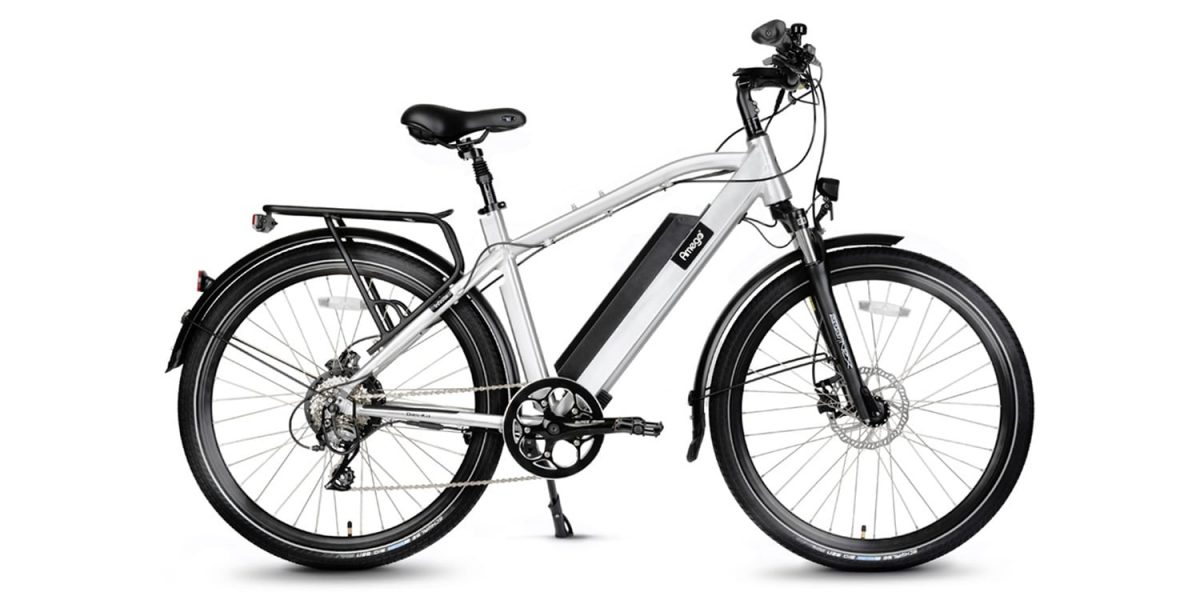












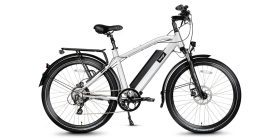
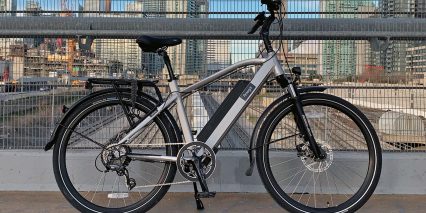
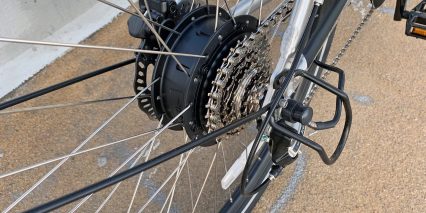
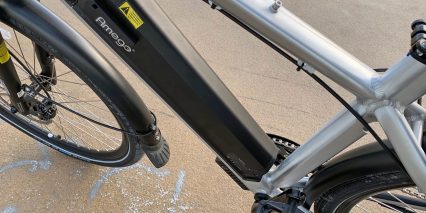
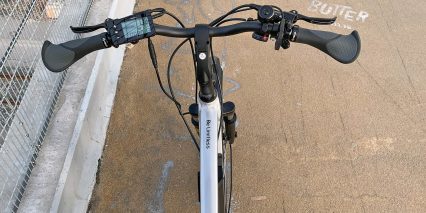
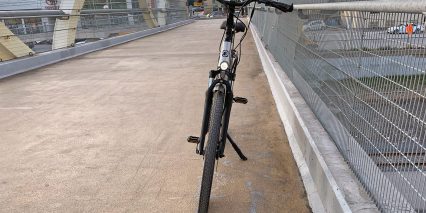
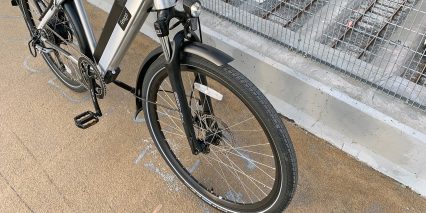
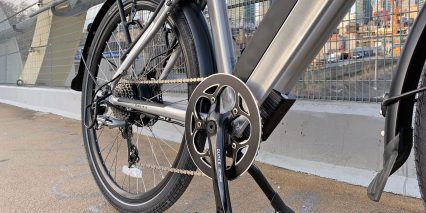
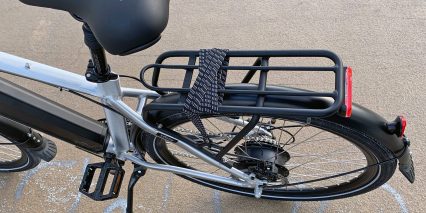
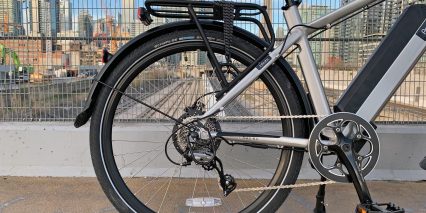

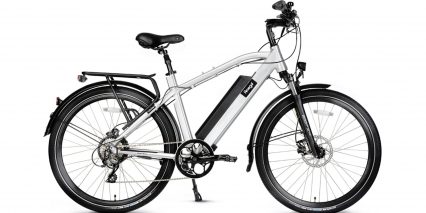
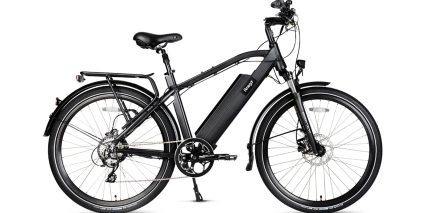

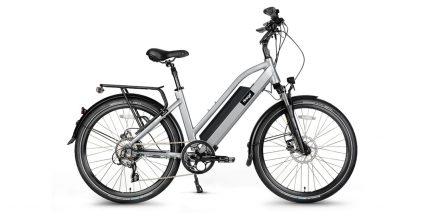
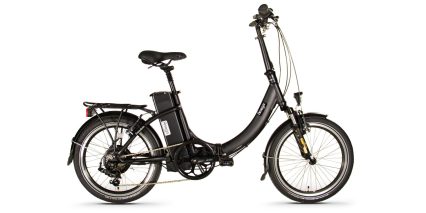
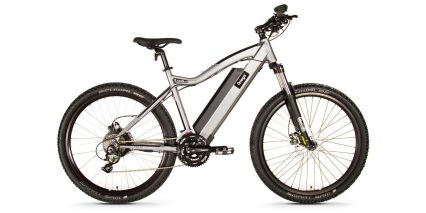
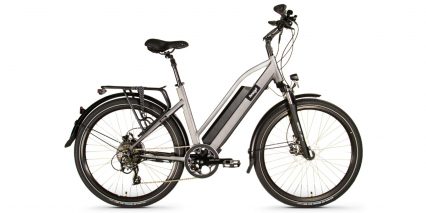
Lg
5 years agoHi, can you please make next year’s model with the computer separate from the peddle assist control? Thank you!
ReplyCourt
5 years agoHi Lg, thanks for sharing your request, I am sure that Amego will continue refining their product with your input. Please note that they may have limited ability to adjust the display and button pads, because they are often made by a third party. Also, My review of the Infinite here is from 2019, so the bike may have already been changed a little bit :)
Reply